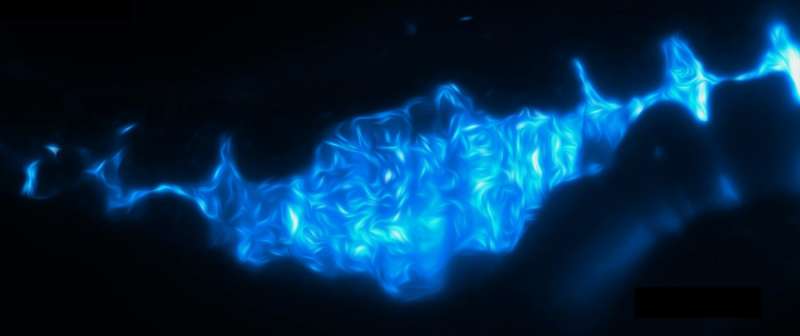Real-time imaging of fish gut ties bacterial competition to gut movements

In recent years, numerous diseases have been tied to variations in gut microbiota. The rapidly growing probiotics industry targets gut and intestinal health by developing products built mostly around enzyme cultures and bacteria. But a new study now suggests that the underlying health and physical forces of the gut are as important as the bacteria inside in shaping communities of intestinal microbiota, and offers insights into the problems experienced by humans with a birth defect called Hirschsprung's disease.
Publishing July 26, 2016 in the open access journal PLOS Biology, University of Oregon scientists have used live zebrafish and 3-D microscopy to track interactions between gut bacteria in real time, leading to an unexpected discovery: mechanical contractions that move contents through the intestine are vitally important drivers of bacterial competition.
"The new findings could help improve such efforts and guide new treatments for diseases of the gastrointestinal system," said Raghuveer Parthasarathy, a professor of physics and the paper's corresponding author. "This research shows that the physical environment and activity of the host intestine can be a major determinant of the bacterial makeup of the gut—an idea that we think should very generally influence how we tackle issues of health and disease."
Initially, researchers used standard non-imaging-based techniques to learn that two bacterial species native to zebrafish—Aeromonas veronii and Vibrio cholerae—show vastly different abundances in the larval zebrafish gut. When zebrafish whose intestines were first colonized by Aeromonas were introduced to Vibrio, Aeromonas populations were small and variable. A conventional interpretation, Parthasarathy said, would point to a reduction of the Aeromonas' growth rate in the presence of Vibrio, but the researchers decided to dig deeper.
To search for a mechanism, the researchers turned to light-sheet fluorescence microscopy—a technique that enables fast, high-resolution 3-D imaging. Using a customized setup developed earlier in Parthasarathy's lab, zebrafish larvae containing the two bacterial species were imaged every 20 minutes for 14 hours, allowing the researchers to precisely map the bacterial populations in the gut.
This revealed sudden, dramatic drops in the Aeromonas populations, dependent on the presence of Vibrio, followed by a rebound to normal growth rates. The Aeromonas population collapses, the researchers found, are tied to peristalsis—the rhythmic contraction and relaxation of the gut. The two bacterial species reacted differently to intestinal motions. Vibrio "spread like a swarm of bees," said Parthasarathy, "and were unperturbed by peristalsis, while Aeromonas aggregated in particular locations that led to their expulsion."
To confirm the connection, the researchers examined the two bacterial species in zebrafish carrying a mutation that leads to the loss of the enteric nervous system, a brain-like network in the tissue lining of the gastrointestinal tract that orchestrates peristalsis. In the absence of peristalsis, the bacteria co-existed without competition.
In humans, this mutation is typical of patients with Hirschsprung's disease, a birth defect that affects nerve cells in the large intestine and the muscles involved in peristalsis. Usually seen in babies soon after birth, it leads to trapped fecal matter, infection and bowel problems. "The findings open a new window on problems occurring in patients with problematic peristalsis," said co-author Judith S. Eisen. "Our work provides new insights into these types of host-microbe interactions and may also prompt new thinking about therapeutic approaches for human disease."
Another co-author, Karen Guillemin, pointed out that "about 30 percent of [Hirschsprung's] patients develop what is called Hirschsprung-associated enterocolitis, which is inflammation of the colon, and is likely to be a consequence of this altered microbiome. Our work provides new mechanistic insight in what could be causing the inflammation."
More information: Wiles TJ, Jemielita M, Baker RP, Schlomann BH, Logan SL, Ganz J, et al. (2016) Host Gut Motility Promotes Competitive Exclusion within a Model Intestinal Microbiota. PLoS Biol 14(7): e1002517. DOI: 10.1371/journal.pbio.1002517
Journal information: PLoS Biology
Provided by Public Library of Science

















